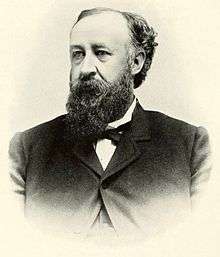Melvin Clark George
| Melvin Clark George | |
|---|---|
 | |
| Member of the U.S. House of Representatives from Oregon's At-large district | |
|
In office March 4, 1881-March 3, 1885 | |
| Preceded by | John Whiteaker |
| Succeeded by | Binger Hermann |
| Member of the Oregon Senate | |
|
In office 1876–1880 | |
| Personal details | |
| Born |
May 13, 1849 Caldwell, Ohio |
| Died |
February 22, 1933 (aged 83) Portland, Oregon |
| Political party | Republican |
| Spouse(s) | Mary Eckler |
Melvin Clark (or Clarke) George (May 13, 1849 – February 22, 1933) was a U.S. Representative from Oregon.
Early life
He was born near Caldwell, Ohio to Presley and Mahala Nickerson George.[1] He moved with his parents over the Oregon Trail in 1851 and settled on a homestead near Lebanon in Linn County, Oregon. In Oregon he attended country schools, then Santiam Academy, and finally Willamette University in Salem.
He served as principal of the Albany schools and the Jefferson Institute in what would become Jefferson. He studied law, and was admitted to the bar and commenced practice in Portland in 1875.[1][2]
In 1873, he married Mary Eckler, with whom he had three children.[1][3]
Political career
George served as member of the Oregon State Senate from Multnomah County from 1876 to 1880.[1][2] In 1880, he was elected as a Republican to Oregon's At-large congressional district in the United States House of Representatives, defeating incumbent John Whiteaker by 1,397 votes.[2][4] In 1882, he defeated Democrat William D. Fenton by 3,365 votes to become the first Oregon congressman to be re-elected to a second term.[4] During his term in Congress, George promoted construction of jetties at the mouth of the Columbia River.[1] He did not seek a third term in 1884.[2]
After Congress
Following his term in Congress, George served as a professor of medical jurisprudence at Willamette University from 1885 to 1889.[1] He served on the Portland school board, and then in 1891, was appointed chairman of the Portland bridge commission, which sought to provide free bridges throughout the city.[1][2][3] In this capacity, George oversaw the construction of the Burnside Bridge. George Park in the St. Johns neighborhood of Portland is named in his honor.[5]
George also served as a Multnomah circuit court judge from 1897 to 1905, and then practiced law in Portland until his death in Portland on February 22, 1933. He is interred at Lone Fir Cemetery.[2]
References
- 1 2 3 4 5 6 7 Corning, Howard M (1956). Dictionary of Oregon History. Binfords & Mort Publishing.
- 1 2 3 4 5 6 "Biographical Directory of the United States Congress". U.S. Government Printing Office. Retrieved 2008-05-14.
- 1 2 "Oregon Native Son" (– Scholar search). 1 (2). Portland, Oregon Native Son Pub. Co. June 1899: 115.
- 1 2 Kincaid, H. R. (1899). Biennial Report of the Secretary of State of the State of Oregon. Salem, Oregon: W. H. Leeds. p. 235.
- ↑ "George Park". Portland Parks and Recreation. Retrieved 2008-05-14.
External links
- United States Congress. "Melvin Clark George (id: G000128)". Biographical Directory of the United States Congress.
![]() This article incorporates public domain material from the Biographical Directory of the United States Congress website http://bioguide.congress.gov.
This article incorporates public domain material from the Biographical Directory of the United States Congress website http://bioguide.congress.gov.
| United States House of Representatives | ||
|---|---|---|
| Preceded by John Whiteaker |
Member of the U.S. House of Representatives from Oregon's at-large congressional district 1881-1885 |
Succeeded by Binger Hermann |